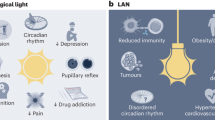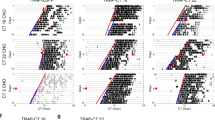Abstract
The mammalian circadian clock resides in neurons of the hypothalamic suprachiasmatic nucleus (SCN). Light entrains phase resetting of the clock using the retino-hypothalamic tract, via release of glutamate. Nighttime light exposure causes rapid, transient induction of clock and immediate–early genes implicated in phase-shifting the pacemaker. Here we show that a nighttime light pulse caused phosphorylation of Ser10 in histone H3's tail, in SCN clock cells. The effect of light was specific, and the kinetics of H3 phosphorylation were characteristic of the early response, paralleling c-fos and Per1 induction. Using fos-lacZ transgenic mice, we found that H3 phosphorylation and Fos induction occurRed in the same SCN neurons. Systemic treatment with the GABAB receptor agonist baclofen prevented light-induced c-fos and Per1 expression and H3 phosphorylation, indicating that one signaling pathway governs both events. Our results suggest that dynamic chromatin remodeling in the SCN occurs in response to a physiological stimulus in vivo.
This is a preview of subscription content, access via your institution
Access options
Subscribe to this journal
Receive 12 print issues and online access
$209.00 per year
only $17.42 per issue
Buy this article
- Purchase on SpringerLink
- Instant access to full article PDF
Prices may be subject to local taxes which are calculated during checkout





Similar content being viewed by others
References
Klein, D., Moore, R. Y. & Reppert, S. M. Suprachiasmatic Nucleus: The Mind's Clock (Oxford Univ. Press, New York, 1991).
Dunlap, J. C. Molecular bases for circadian clocks. Cell 96, 271–290 (1999).
Cermakian, N. & Sassone-Corsi, P. Multilevel regulation of the circadian clock. Nat. Reviews Mol. Cell Biol. 1, 59–67 (2000).
Daan, S. & Pittendrigh, C. S. A functional analysis of circadian pacemakers in nocturnal rodents. II. The variability of phase response curves. J. Comp. Physiol. 106, 253–266 (1976).
Moore, R. Y. & Lenn, N. Y. A retinohypothalamic projection in the rat. J. Comp. Neurol. 146, 1–14 (1972).
Ding, J. M. et al. Resetting the biological clock: mediation of nocturnal circadian shifts by glutamate and NO. Science 266, 1713–1717 (1994).
Card, J. P. & Moore, R. Y. Organization of lateral geniculate-hypothalamic connections in the rat. J. Comp. Neurol. 284, 135–147 (1989).
Moore, R. Y. & Speh, J. C. GABA is the principal neurotransmitter of the circadian system. Neurosci. Lett. 150, 112–116 (1993).
Pickard, G. E. & Rea, M. A. Serotonergic innervation of the hypothalamic suprachiasmatic nucleus and photic regulation of circadian rhythms. Biol. Cell 89, 513–523 (1997).
Johnson, R. F., Moore, R. Y. & Morin, L. P. Loss of entrainment and anatomical plasticity after lesions of the hamster retinohypothalamic tract. Brain Res. 460, 297–313 (1988).
Harrington, M. E. & Rusak, B. Lesions of the thalamic intergeniculate leaflet alter hamster circadian rhythms. J. Biol. Rhythms. 1, 309–325 (1986).
Albrecht, U., Sun, Z. S., Eichele, G. & Lee, C. C. A differential response of two putative mammalian circadian regulators, mper1 and mper2, to light. Cell 91, 1055–1064 (1997).
Shearman, L. P., Zylka, M. J., Weaver, D. R., Kolakowski, L. F. Jr. & Reppert, S. M. Two period homologs: circadian expression and photic regulation in the suprachiasmatic nuclei. Neuron 19, 1261–1269 (1997).
Kornhauser, J. M., Nelson, D. E., Mayo, K. E. & Takahashi, J. S. Photic and circadian regulation of c-fos gene expression in the hamster suprachiasmatic nucleus. Neuron 5, 127–134 (1990).
Morris, M. E., Viswanathan, N., Kuhlman, S., Davis, F. C. & Weitz, C. J. A screen for genes induced in the suprachiasmatic nucleus by light. Science 279, 1544–1547 (1998).
Wollnik, F. et al. Block of c-Fos and JunB expression by antisense oligonucleotides inhibits light-induced phase shifts of the mammalian circadian clock. Eur. J. Neurosci. 7, 388–393 (1995).
Akiyama, M. et al. Inhibition of light- or glutamate-induced mPer1 expression represses the phase shifts into the mouse circadian locomotor and suprachiasmatic firing rhythms. J. Neurosci. 19, 1115–1121 (1999).
Obrietan, K., Impey, S. & Storm, D. R. Light and circadian rhythmicity regulate MAP kinase activation in the suprachiasmatic nuclei. Nat. Neurosci. 1, 693–700 (1998).
Ginty, D. D. et al. Regulation of CREB phosphorylation in the suprachiasmatic nucleus by light and a circadian clock. Science 260, 238–241 (1993).
De Cesare, D., Fimia, G. M. & Sassone-Corsi, P. Signaling routes to CREM and CREB: plasticity in transcriptional activation. Trends Biochem. Sci. 24, 281–285 (1999).
Belvin, M. P., Zhou, H. & Yin, J. C. The Drosophila dCREB2 gene affects the circadian clock. Neuron 22, 777–787 (1999).
Obrietan, K., Impey, S., Smith, D., Athos, J. & Storm, D. R. Circadian regulation of cAMP response element-mediated gene expression in the suprachiasmatic nuclei. J. Biol. Chem. 274, 17748–17756 (1999).
Cheung, P., Allis, C. D. & Sassone-Corsi, P. Signaling to chromatin through histone modifications. Cell 103, 263–271 (2000).
Workman, J. L. & Kingston, R. E. Alteration of nucleosome structure as a mechanism of transcriptional regulation. Annu. Rev. Biochem. 67, 545–579 (1998).
Sassone-Corsi, P. et al. Requirement of Rsk-2 for epidermal growth factor-activated phosphorylation of histone H3. Science 285, 886–891 (1999).
Thomson, S. et al. The nucleosomal response associated with immediate-early gene induction is mediated via alternative MAP kinase cascades: MSK1 as a potential histone H3/HMG-14 kinase. EMBO J. 18, 4779–4793 (1999).
De Cesare, D., Jacquot, S., Hanauer, A. & Sassone-Corsi, P. Rsk-2 activity is necessary for epidermal growth factor-induced phosphorylation of CREB protein and transcription of c-fos gene. Proc. Natl. Acad. Sci. USA 95, 12202–12207 (1998).
Cheung, P. et al. Synergistic coupling of histone H3 phosphorylation and acetylation in response to epidermal growth factor. Mol. Cell 5, 905–915 (2000).
Colwell, C. S., Kaufman, C. M. & Menaker, M. Photic induction of Fos in the hamster suprachiasmatic nucleus is inhibited by baclofen but not by diazepam or bicucullin. Neurosci. Lett. 163, 177–181 (1993).
Gillespie, C. F. et al. GABAergic regulation of light-induced c-Fos immunoreactivity within the suprachiasmatic nucleus. J. Comp. Neurol. 411, 683–692 (1999).
Hendzel, M. J. et al. Mitosis-specific phosphorylation of histone H3 initiates primarily within pericentromeric heterochromatin during G2 and spreads in an ordered fashion coincident with mitotic chromosome condensation. Chromosoma 106, 348–360 (1997).
Silver, R. et al. Multiple regulatory elements result in regional specificity in circadian rhythms of neuropeptide expression in mouse SCN. Neuroreport 10, 3165–3174 (1999).
Robertson, L. M. et al. Regulation of c-fos expression in transgenic mice requires multiple interdependent transcription control elements. Neuron 14, 241–252 (1995).
Cui, L. N., Saeb-Parsy, K. & Dyball, R. E. Neurones in the supraoptic nucleus of the rat are regulated by a projection from the suprachiasmatic nucleus. J. Physiol. (Lond.) 502, 149–159 (1997).
Cui, L. N., Coderre, E. & Renaud, L. P. GABA(B) presynaptically modulates suprachiasmatic input to hypothalamic paraventricular magnocellular neurons. Am. J. Physiol. 278, R1210–1216 (2000).
Wang, K., Guldenaar, S. E. & McCabe, J. T. Fos and Jun expression in rat supraoptic nucleus neurons after acute vs. repeated osmotic stimulation. Brain Res. 746, 117–125 (1997).
Berquin, P., Bodineau, L., Gros, F. & Larnicol, N. Brainstem and hypothalamic areas involved in respiratory chemoreflexes: a Fos study in adult rats. Brain Res. 857, 30–40 (2000).
Honrado, G. I. et al. The circadian system of c-fos deficient mice. J. Comp. Physiol. A 178, 563–570 (1996).
Colwell, C. S., Kaufman, C. M. & Menaker, M. Phase-shifting mechanisms in the mammalian circadian system: new light on the carbachol paradox. J. Neurosci. 13, 1454–1459 (1993).
Weber, E. T., Gannon, R. L., Michel, A. M., Gillette, M. U. & Rea, M. A. Nitric oxide synthase inhibitor blocks light-induced phase shifts of the circadian activity rhythm, but not c-fos expression in the suprachiasmatic nucleus of the Syrian hamster. Brain Res. 692, 137–142 (1995).
Xing, J., Ginty, D. D. & Greenberg, M. E. Coupling of the RAS-MAPK pathway to gene activation by RSK2, a growth factor-regulated CREB kinase. Science 273, 959–963 (1996).
Hollmann, M. & Heinemann, S. Cloned glutamate receptors. Annu. Rev. Neurosci. 17, 31–108 (1994).
Bormann, J. The 'ABC' of GABA receptors. Trends Pharmacol. Sci. 21, 16–19 (2000).
Bourque, C. W. & Oliet, S. H. Osmoreceptors in the central nervous system. Annu. Rev. Physiol. 59, 601–619 (1997).
Liu, C. & Reppert, S. M. GABA synchronizes clock cells within the suprachiasmatic circadian clock. Neuron 25, 123–128 (2000).
Shinohara, K., Hiruma, H., Funabashi, T. & Kimura, F. GABAergic modulation of gap junction communication in slice cultures of the rat suprachiasmatic nucleus. Neuroscience 96, 591–596 (2000).
Shibata, K., Inagaki, M. & Ajiro, K. Mitosis-specific histone H3 phosphorylation in vitro in nucleosome structures. Eur. J. Biochem. 192, 87–93 (1990).
Ceriani, M. F. et al. Light-dependent sequestration of TIMELESS by CRYPTOCHROME. Science 285, 553–556 (1999).
van der Horst, G. T. et al. Mammalian Cry1 and Cry2 are essential for maintenance of circadian rhythms. Nature 398, 627–630 (1999).
Whitmore, D., Foulkes, N. S. & Sassone-Corsi, P. Light acts directly on organs and cells in culture to set the vertebrate circadian clock. Nature 404, 87–91 (2000).
Acknowledgements
We thank T. Curran for the fos-lacZ transgenic mouse line. We thank H. Tei for the mPer1 cDNA, J. L. Vonesch for advice with confocal microscopy, E. Borrelli for reading the manuscript and E. Heitz and M. Rastegar for technical assistance. We thank Z. Travnickova, D. Whitmore, N. Foulkes, M. Pando and all members of the Sassone-Corsi laboratory for discussions and help. C.C. is supported by a postdoctoral fellowship from the European Community and N.C. by a Human Frontier Science Program long-term fellowship and a Canadian Institutes of Health Research postdoctoral fellowship. This work was supported by grants from Centre National de la Recherche Scientifique, Institut National de la Santé et de la Recherche Médicale, Centre Hospitalier Universitaire Régional, Fondation de la Recherche Médicale, Université Louis Pasteur, Human Frontier Science Program, Organon (Akzo/Nobel) and Association pour la Recherche sur le Cancer.
Author information
Authors and Affiliations
Corresponding author
Rights and permissions
About this article
Cite this article
Crosio, C., Cermakian, N., Allis, C. et al. Light induces chromatin modification in cells of the mammalian circadian clock. Nat Neurosci 3, 1241–1247 (2000). https://doi.org/10.1038/81767
Received:
Accepted:
Issue Date:
DOI: https://doi.org/10.1038/81767
This article is cited by
-
PER2 mediates CREB-dependent light induction of the clock gene Per1
Scientific Reports (2021)
-
Rebelled epigenome: histone H3S10 phosphorylation and H3S10 kinases in cancer biology and therapy
Clinical Epigenetics (2020)
-
Metabolic rivalry: circadian homeostasis and tumorigenesis
Nature Reviews Cancer (2020)
-
Disruption of the Molecular Circadian Clock and Cancer: An Epigenetic Link
Biochemical Genetics (2020)
-
Circadian rhythms in the three-dimensional genome: implications of chromatin interactions for cyclic transcription
Clinical Epigenetics (2019)



